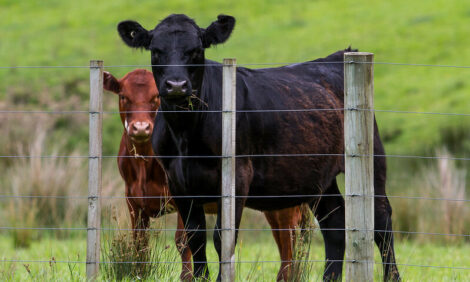



Farmers Urged to Act Now to Limit Drought Impact on Feed Stocks
UK - Livestock farmers are being urged to take steps now to make the most of feed stocks and limit the effects of the exceptionally dry conditions on farm.The topic has come up at a number of recent Monitor Farm Scotland meetings, including events at the Morayshire and Borders monitor farms. At the recent Morayshire Monitor farm meeting the advice was Plan, prepare and don’t panic and a practical guidance sheet was circulated for farmers concerned about coping with drastically reduced feed stocks.
The guidance was repeated at the Nithsdale Monitor Farm Open Day held yesterday (Thursday, 19 July) at Clonhie near Thornhill, when consultant Rhidian Jones from RJ Livestock Systems, part of the 5Agri group, outlined potential solutions to managing feed supply and demand during droughts
"The current dry spell we are experiencing is unprecedented in recent years and follows a late spring where silage stocks were used up and more concentrate feeding was required," said Mr Jones.
"It is inevitable that it will be a costly year for livestock farmers, but there are some basic steps that can be taken to alleviate the situation. The key is for farmers to do these things now and not wait until they are forced into actions when they have no choice."
He suggested that farmers establish a feed budget as a useful first step to work out what feeds are currently available and how much livestock can be carried with that feed. He also highlights several things that livestock farmers could consider to try and increase the supply of forage on their farm.
Stitching in some Italian Ryegrass with/without forage rape or stubble turnips to some fields will provide a supply of feed in the autumn, early winter and an early bite for the spring. Italian ryegrass will last 12-18 months and should give a silage crop next year as well.
Applying nitrogen in small quantities (20-30kgN/ha) where there may be heavy dew in the mornings or rain forecast will also help boost grass growth.
Alternative sources of feed should also be explored, whether it is hay, straw, moist feed, by-products or waste vegetables, and in some areas it might be feasible to cut poorer cereals for whole crop.
Depending on location, it may also be worth talking to arable neighbours to determine whether cereal crops can be made into wholecrop silage or whether there are windows in their rotation where stubble turnips can be sown after the cereal is harvested. Any silage or wholecrop that is made should be well wilted to reduce straw requirements in winter.
As well as trying to identify ways to increase the feed supply Mr Jones suggested ways to reduce feed demand.
"Consider weaning lambs once they are 12 weeks of age," said Mr Jones.
"From eight weeks they will be deriving more nutrition from grass than milk and will be directly competing with ewes for valuable grass. The ewes’ DM requirements will be more than halved and they can be dried off on very little grass."
Another suggestion he gave was to consider selling cull ewes earlier to reduce demand on grazing as well as selling store lambs earlier in the year if they can.
Cattle farmers may also wish to scan their cows earlier and then sell any barren cows at the earliest opportunity. They may also benefit from weaning autumn born calves as soon as they can, and wean spring born calves at 250 kg or 5-6 months of age. This will leave some body condition on the cows, which will also save feed in the winter.
"Creep feeding calves earlier will boost calf growth rates and help to take the pressure off the cows and grassland," said Mr Jones.
"This may also help conception rates of the cows depending on when the bulls are put in," he added.
Finally, he said, housing finishing cattle earlier on a more intensive diet may cost more per day but will mean that the cattle take less time to finish and less straw will be used as well.
Mr Jones stressed that there may be other options open to farmers, but the key is to take action now before the situation worsens.
"This may also be an opportune time to have a more strategic look at your farm business in terms of stocking density, enterprise mix, wintering options, resilience to cope with extreme conditions and whether investment is required for future sustainability," he added.
The Monitor Farm Scotland Programme is a joint initiative by Quality Meat Scotland (QMS) and AHDB Cereals & Oilseeds with funding from the Scottish Government. The aim of the programme is to help improve the productivity, profitability and sustainability of Scottish farm businesses through establishing a network for nine monitor farms throughout Scotland.
For more information about the monitor farm programme and to download a copy of the guidance sheet with suggestions for farmers to cope with reduced feed stocks, visit www.monitorfarms.co.uk.



